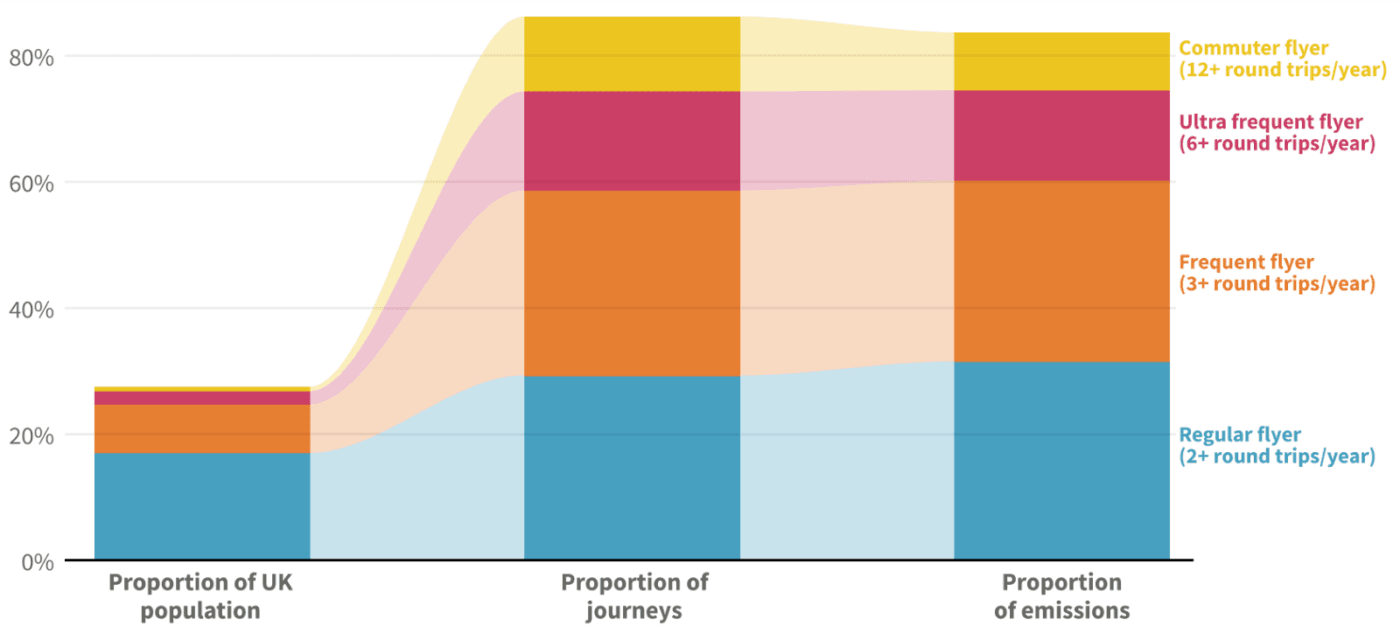Introducing: the ultra-frequent flyer
Meet the real beneficiaries of the UK government’s airport obsession
18 June 2025
Over the last 20 years the number of passengers flying in and out of UK airports has grown dramatically, from around 220 million to 300 million today. The UK, or more accurately London, remains among the best-connected places in the world. But with this government in the middle of rolling out another huge expansion in airports – enough to move 100 million more passengers – it’s worth looking back to see who has really benefited from two decades of aviation growth.
NEF analysis using the National Travel Survey and Civil Aviation Authority Passenger Survey shows that UK-resident frequent flyers were responsible for 63% of the new passenger traffic seen over the past two decades. A further 13% was captured by infrequent UK-resident flyers, and 24% by foreign residents (many of whom are also frequent flyers). Remarkably, the number of UK residents not flying at all each year actually increased over the period.
But to fully understand what’s going on, we have to go deeper. Since our first report on a frequent flyer levy in 2015, NEF and Possible have popularised the idea of targeting policy at the frequent flyer: individuals who take three or more return flights a year. But in 2025, this definition is inadequate.
Among the frequent flyers, our analysis identifies a new sub-group: “ultra-frequent” flyers. These people take six or more return trips a year, and they are the biggest drivers of the UK’s growth in passenger numbers. Ultra-frequent flyers make up less than 3% of the UK population but take 30% of all journeys made by UK residents. Because of their rapid growth, we estimate that UK ultra-frequent flyers captured 39% of passenger growth over the past two decades. Throw foreign residents into the mix and it is likely that ultra-frequent flyers captured almost half of all new air travel capacity added to the UK since 2006.
Figure: Ultra-frequent flyers are a tiny proportion of the UK population, but are responsible for a significant chunk of air journeys and emissions
UK-resident air passengers grouped by their flight frequency, share of journeys, and share of greenhouse gas emissions in 2019

Source: NEF analysis of the CAA Passenger Survey (2019)
Through deep-dive analysis of the Civil Aviation Authority’s passenger survey, we can find out more about the ultra-frequent flyer:
- Their household incomes are well above that of the average air passenger (around 37% higher on average).
- They are far more likely to fly in the luxury classes (around twice as likely to fly business or first class).
- They are more likely to fly on short-haul routes that could be done by train (typically flying to destinations around 20% closer to home than the average passenger).
- Most of their travel is for leisure, not business (we estimate post-pandemic, around one-third of their flights are for business purposes).
- As a result of the above, they are consuming vastly more than their fair share of the aviation sector’s carbon budget (around eight times their equal share if the sector’s emissions were spread equally across the UK population).
Among the favoured destinations of ultra-frequent flyers are places already accessible via direct train, such as Edinburgh, Glasgow and Amsterdam. Also common are destinations that could be much easier to reach by train, with the right rail policy. If this government and rail operators made better use of channel tunnel capacity, favoured destinations of ultra-frequent flyers like Frankfurt, Geneva and Barcelona, all currently reachable with just one rail connection in Paris, could be even more accessible.
The bulk of the growth we see in contemporary air travel is driven by the luxury trips of ultra-frequent flyers. Their trips are more a product of the extremely low cost of travel – facilitated by its under-taxation – than they are evidence of a need to travel (which is generally low, as evidenced by new research from the Dutch Government). A new tax mechanism would encourage ultra-frequent flyers to make more sustainable choices and cut back on their climate-wrecking travel habits: an ultra-frequent flyer levy.
Unlike our previous frequent flyer levy proposals, the ultra-frequent flyer levy would not be a ticket tax. We propose introducing a new charge, payable through the personal annual tax return, which applies only to individuals flying six or more times in the previous 12-month period. The charge would encourage ultra-frequent flyers to plan the year ahead in a climate-friendly way, and where possible consider flying less or travelling by train.
This proposal emerged from legal advice we received in relation to last year’s report on A Frequent Flyer Levy in Europe, which identified this form of levy as the easiest and quickest for government to implement. The levy also holds the advantage that it is unequivocally focused on the most excessive travellers, and presents less financial risk for individuals who are faced with a sudden and vital need to fly. For more on NEF’s package of aviation tax policy proposals, and detailed methods, see our new report, Flying fair: modernising the air transport tax system.
Image: ljubaphoto
Topics Climate change Transport






